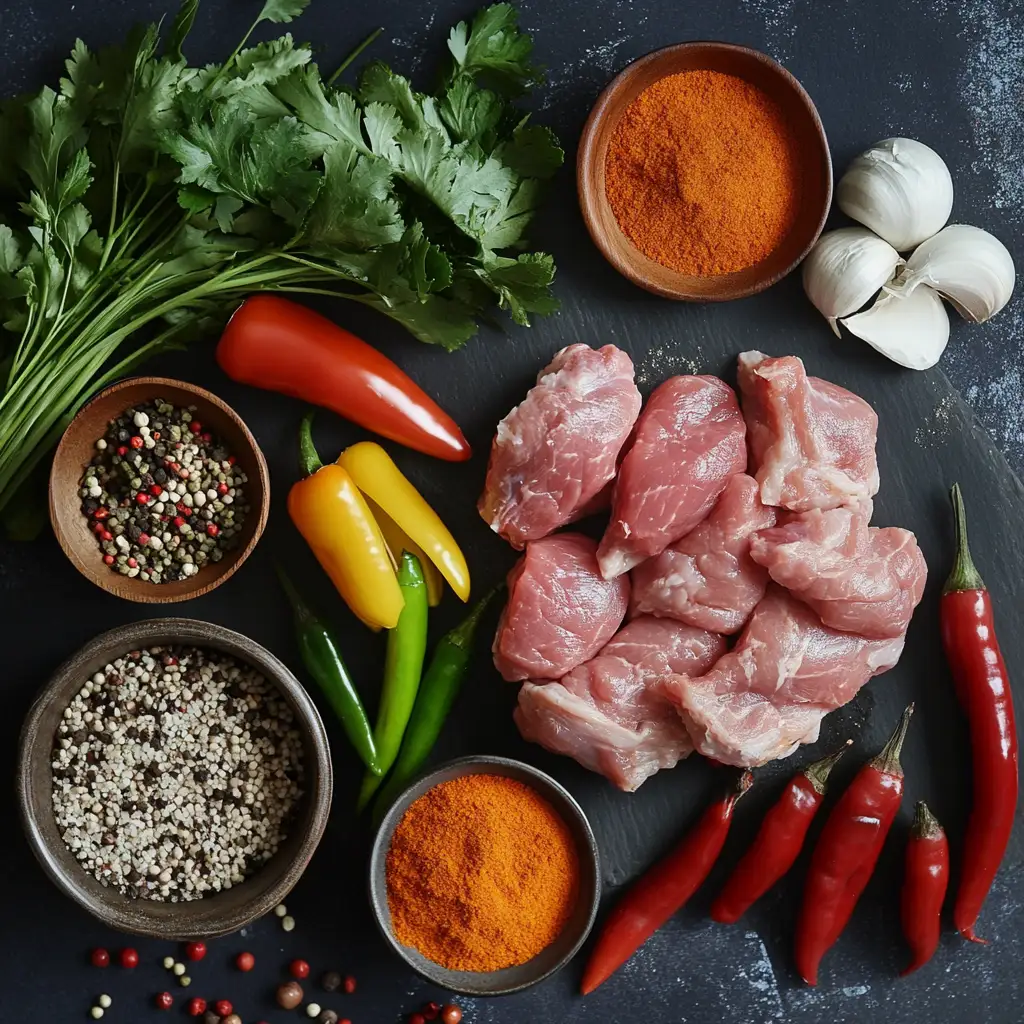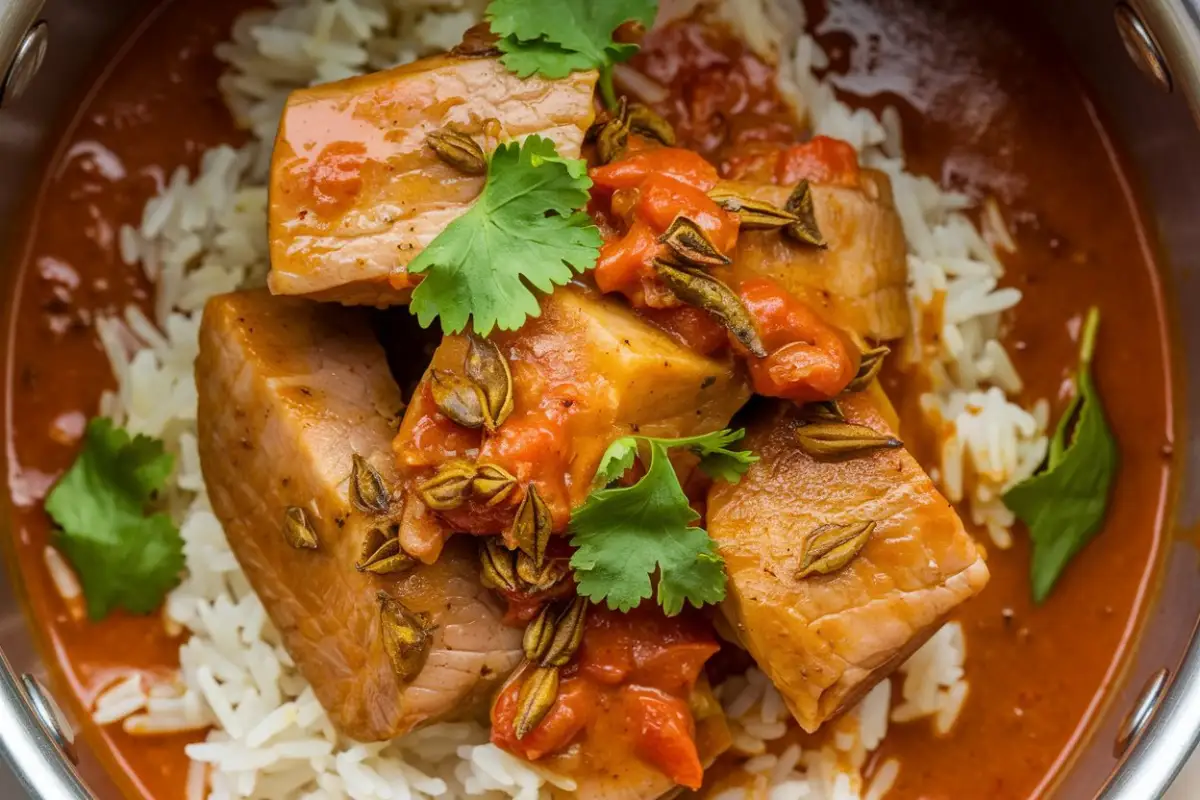Are you ready to dive into the delicious, aromatic world of pork curry? Whether you’re a seasoned home cook or a newbie in the kitchen, This guide will walk you through everything to make the ultimate Pork Curry Recipe you need to know to make a mouthwatering pork curry. From picking the perfect cut of pork to nailing the flavors with spices, this recipe isn’t just a meal—it’s an experience.
What is Pork Curry?
Pork curry is more than just a dish; it’s a celebration of flavors and cultures. Typically made with succulent pieces of pork simmered in a rich, spiced gravy, this dish has endless variations across the globe. Whether it’s a fiery Indian version or a creamy Thai-inspired delight, pork curry is all about bold flavors that keep you coming back for more.
Why Pork Curry Recipe is Popular Around the World
Why is pork curry so universally loved? Well, think about it. Pork is incredibly versatile—it soaks up spices like a sponge, becoming tender and flavorful as it cooks. Add to that the comforting, hearty appeal of a well-made curry, and you’ve got a dish that’s hard to resist. Plus, pork curry offers something for everyone, Whether you love a spicy kick or creamy flavors, there’s a Pork Curry Recipe variation for everyone.
Choosing the Right Ingredients for a Perfect Pork Curry Recipe

Selecting the Best Cut of Pork for Your Pork Curry Recipe
The key to a great Pork Curry Recipe starts with choosing the right cut of meat. For a tender and flavorful dish, opt for cuts with a bit of fat like pork shoulder or pork belly. These cuts break down beautifully during cooking, giving your curry a melt-in-your-mouth texture. Want something leaner? Pork loin works too, but be careful—it can dry out if overcooked.
Essential Spices for an Authentic Pork Curry Recipe
What’s a curry without its spices? Here’s a quick rundown of must-haves:
- Turmeric for that golden hue.
- Cumin and coriander for earthy warmth.
- Chili powder to bring the heat.
- Garam masala for a fragrant finish.
- Fresh ginger and garlic for that unmistakable zing.
Remember, spices are like the soul of your curry. Toast them lightly to release their oils, and you’ll notice a world of difference in your dish.
Fresh vs. Store-Bought Curry Paste: What Works Best for a Pork Curry Recipe?
Here’s the deal—fresh is always better. If you’ve got the time, whipping up your own curry paste can take your dish to the next level. Blend fresh chilies, ginger, garlic, and spices into a paste, and you’ll taste the difference in every bite. Short on time? Store-bought pastes can work too, but choose high-quality ones with no artificial additives.
Preparing Your Pork Curry
Step-by-Step Guide to Prepping Pork for a Pork Curry Recipe
Preparation is key to a flavorful curry. Start by trimming any excess fat from the pork and cutting it into bite-sized pieces. Don’t rush this step—uniform pieces cook evenly, so you won’t end up with some chunks overdone and others undercooked.
Best Cooking Techniques for a Flavorful Pork Curry Recipe
Here’s a pro tip: marinate your pork before cooking. A simple marinade of yogurt, turmeric, ginger, and garlic can work wonders, tenderizing the meat and infusing it with flavor. Let it sit for at least 30 minutes (or longer if you’ve got the time). Trust me, This step is essential for achieving a tender and flavorful Pork Curry Recipe.
Cooking Techniques for Pork Curry
The Slow-Cooking Method: Tenderizing the Pork
Patience is the secret ingredient in any good Pork Curry Recipe. Slow cooking your pork allows it to soak up all the spices, becoming tender and juicy. You can use a stovetop pot, a slow cooker, or even an oven for this. The key? Low and slow. Let the pork simmer in the curry sauce until it’s fall-apart tender—this could take 1.5 to 2 hours, but the result is worth every second.
Imagine the aroma filling your kitchen as the flavors meld together. That’s the magic of slow cooking! Plus, this method ensures your curry has a rich, concentrated flavor that’s hard to achieve with faster cooking techniques.
One-Pot Cooking: Simplifying the Process
Don’t want to deal with multiple pots and pans? Go the one-pot route! Start by sautéing onions, garlic, and ginger directly in the pot with some oil. Then, add your spices, pork, and liquids (like stock or coconut milk). Cover it up and let the magic happen. One-pot cooking not only simplifies cleanup but also locks in all the flavors.
Using a Pressure Cooker for Fast and Flavorful Results
Short on time? A pressure cooker is your best friend. It dramatically cuts down the cooking time while delivering the same tender results. Add your ingredients, seal the lid, and let the pressure cooker do its thing. In 30-40 minutes, you’ll have a curry that tastes like it’s been simmering all day. Just be careful not to overdo it—the pork should hold its shape but still be fork-tender.
Pork Curry Variations
Spicy Pork Curry: Turning Up the Heat
For those who love a fiery kick, a spicy pork curry is the way to go. Add extra chili powder, fresh green chilies, or even a dollop of spicy chili paste to the base. Balance the heat with a squeeze of fresh lime juice or a dollop of yogurt just before serving—it’ll cool things down while enhancing the overall flavor.
Coconut-Based Pork Curry for a Creamy Twist
If you’re a fan of rich and creamy curries, coconut milk is your hero. Add it towards the end of the cooking process to avoid curdling. The natural sweetness of coconut milk pairs beautifully with the spices, creating a velvety texture that’s hard to resist. Garnish with fresh cilantro and serve with steamed rice for a tropical touch.
Regional Pork Curry Recipes to Try
Every region has its own take on pork curry, each offering a unique flavor profile.
- Indian Pork Vindaloo: A tangy, spicy dish with vinegar and plenty of chilies.
- Thai Red Curry: A fragrant and creamy version made with red curry paste and coconut milk.
- Filipino Adobo-Inspired Curry: A soy sauce and vinegar base with a hint of sweetness.
Exploring regional variations is like taking your taste buds on a world tour.
Common Problems and Their Solutions
Why Is My Pork Curry Tough?
Ever had a curry where the pork feels like chewing on rubber? The culprit is often overcooking or using the wrong cut of meat. Stick to cuts like pork shoulder or belly for the best results. If your pork is already tough, don’t worry—let it simmer for a longer time on low heat. This helps break down the connective tissue, making the meat tender.
Fixing Bland Pork Curry: Enhancing Flavor
Does your curry lack that punch of flavor? A common mistake is under-seasoning. Add a pinch of salt, a squeeze of lime, or even a dash of garam masala towards the end of cooking to boost the taste. Another trick? Toast your spices before adding them to the dish—this releases their oils, intensifying their flavor.
Avoiding Greasiness: Tips for a Balanced Texture
If your curry feels greasy, it’s likely because of too much fat in the pork or excessive oil. Skim off excess fat during cooking or use a paper towel to blot it away before serving. Choosing leaner cuts of pork and measuring your cooking oil carefully can also help.
Pairing Pork Curry with Sides
Traditional Rice Options to Serve with Pork Curry
Rice and curry are a match made in heaven. For pork curry, consider these options:
- Steamed Jasmine Rice: Light and aromatic, perfect for soaking up the curry sauce.
- Basmati Rice: Its fluffy texture and subtle flavor complement the spices beautifully.
- Coconut Rice: For a sweeter, richer pairing.
Bread Choices: Naan, Roti, and More
Bread lovers, rejoice! Flatbreads like naan or roti are excellent for scooping up every last bit of that delicious curry. If you’re feeling adventurous, try making your own naan at home—it’s simpler than you think and adds a personal touch to your meal.
Frequently Asked Questions (FAQs) About Pork Curry
Can I use lean cuts of pork for curry?
Absolutely! While fattier cuts like pork shoulder or belly add richness, lean cuts like pork loin can work too. Just keep an eye on the cooking time, as leaner meat tends to dry out if overcooked. Marinating can also help keep lean cuts juicy and flavorful.
How do I make my pork curry less spicy?
If your curry turned out too spicy, don’t worry—there are ways to fix it! Add a dollop of yogurt, cream, or coconut milk to mellow the heat. You can also toss in some diced potatoes; they’ll absorb some of the spiciness as they cook.
What’s the best way to reheat pork curry?
Reheating pork curry is simple, but there’s a trick to maintain its flavor and texture. Heat it slowly over low heat on the stovetop, stirring occasionally. If it’s too thick, add a splash of water or coconut milk to loosen it up. Avoid microwaving as it can dry out the meat.
Can I freeze pork curry?
Yes! Pork curry freezes wonderfully, making it a great make-ahead meal. Let it cool completely, then transfer it to an airtight container. It’ll stay fresh in the freezer for up to 3 months. When reheating, thaw it overnight in the fridge for the best texture and flavor.
How do I thicken my pork curry?
If your curry is too thin, you can thicken it in a few ways:
- Let it simmer uncovered to reduce the liquid.
- Stir in a mixture of cornstarch and water.
- Mash a few pieces of potato directly into the curry for natural thickening.
What sides go best with pork curry?
Rice, naan, or roti are classic pairings. For something different, try serving it with a side of roasted vegetables, a simple cucumber salad, or even quinoa for a healthier twist.
How long does pork curry last in the fridge?
Stored properly in an airtight container, pork curry can last 3-4 days in the fridge. Reheat it thoroughly before serving, and make sure it smells and tastes fresh before eating.
Can I substitute pork with another protein?
Of course! If pork isn’t your thing, you can easily swap it out for chicken, beef, or even tofu for a vegetarian version. Just adjust the cooking times based on the protein you choose.
What’s the best way to balance flavors in pork curry?
Balancing flavors is all about tasting as you go. If it’s too salty, add a pinch of sugar or a splash of cream. Too spicy? Add yogurt or coconut milk. Too bland? A squeeze of lime or a sprinkle of garam masala can bring it to life.
Conclusion
Making the perfect Pork Curry Recipe is an adventure worth taking.From selecting the right cut of pork to blending the perfect mix of spices, every step is an opportunity to create something truly magical. Whether you’re slow-cooking for hours or whipping up a quick batch in your pressure cooker, the result is always a comforting, flavor-packed dish that brings people together.
Remember, the beauty of pork curry lies in its versatility. Experiment with spices, try regional variations, or tweak the recipe to suit your taste. Don’t worry about making mistakes—cooking is as much about the journey as it is about the destination. And when you serve that steaming bowl of curry with your favorite sides, you’ll know it was all worth it.
So, what are you waiting for? Put on your apron, gather your ingredients, and get cooking. Your perfect pork curry awaits! And don’t forget—great curries are made with love, a little patience, and a generous sprinkle of creativity.

